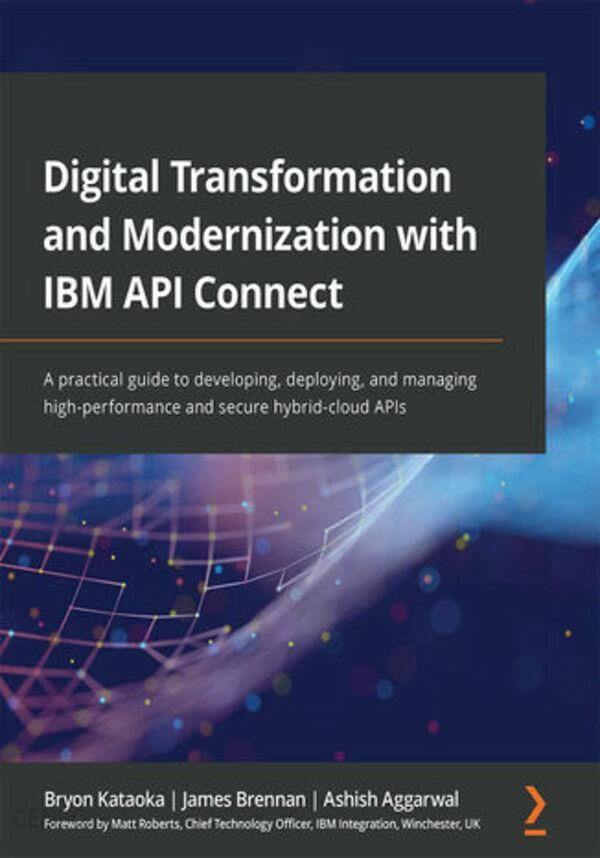Description
IBM API Connect enables organizations to drive digital innovation using its scalable and robust API management capabilities across multi-cloud and hybrid environments. With API Connects security, flexibility, and high performance, youll be able to meet the needs of your enterprise and clients by extending your API footprint. This book provides a complete roadmap to create, manage, govern, and publish your APIs.Youll start by learning about API Connect components, such as API managers, developer portals, gateways, and analytics subsystems, as well as the management capabilities provided by CLI commands. Youll then develop APIs using OpenAPI and discover how you can enhance them with logic policies. The book shows you how to modernize SOAP and FHIR REST services as secure APIs with authentication, OAuth2/OpenID, and JWT, and demonstrates how API Connect provides safeguards for GraphQL APIs as well as published APIs that are easy to discover and well documented. As you advance, the book guides you in generating unit tests that supplement DevOps pipelines using Git and Jenkins for improved agility, and concludes with best practices for implementing API governance and customizing API Connect components.By the end of this book, youll have learned how to transform your business by speeding up the time-to-market of your products and increase the ROI for your enterprise. Spis treści:Digital Transformation and Modernization with IBM API ConnectForewordContributorsAbout the authorsAbout the reviewersPrefaceWho this book is forWhat this book coversTo get the most out of this bookDownload the example code filesDownload the color imagesConventions usedGet in touchShare Your ThoughtsSection 1: Digital Transformation and API ConnectChapter 1: Digital Transformation and Modernization with API ConnectAPI-led digital transformationA journey back in timeFast forward to the 21st centuryBusiness transformation to a digital transformation frameworkDigital framework considerationsHybrid reference architectureAPI-led architectural approachAPI flavorsYour responsibilities for APIsDigital modernization and APIsApproaches to modernizationAPI Connect enabling digital transformationAPI Connect aligns with the goals of digital transformationSummaryChapter 2: Introducing API ConnectTechnical requirementsAPI ConnectThe components of API ConnectDeployment modelsThe on-premises implementationCloud implementationsHybrid cloudHAIntroduction to the CLI commandsHaving fun playing with FHIRSummaryChapter 3: Setting Up and Getting OrganizedTechnical requirementsThe big pictureProvider OrganizationsConfiguring your Provider OrganizationAPI CatalogsConfiguring your API CatalogUtilizing SpacesConfiguring your spacesDeveloper PortalConfiguring the Developer PortalSummarySection 2: Agility in DevelopmentChapter 4: API CreationTechnical requirementsDevelopment toolsInstalling DesignerInstalling the LTEConnecting Designer to the LTECreating APIsWhat is an OpenAPI design?Creating an API ProxyTesting APIsUsing variablesAdding policiesSummaryChapter 5: Modernizing SOAP ServicesTechnical requirementsSOAP capabilities in APICCreating a SOAP proxy that invokes a SOAP serviceCreating a SOAP proxyReview SOAP Proxy configurationTesting the SOAP ProxyCreate a REST proxy that invokes a SOAP serviceCreating a REST proxyReview the REST proxy configurationTesting the REST ProxySummaryChapter 6: Supporting FHIR REST ServicesTechnical requirementsIntroducing FHIRFHIR resourcesFHIR serverGovernment-mandated FHIR interfacesCreating a RESTful FHIR APIPlaying with FHIRApplying logic policies to your FHIR APIThe If and Switch logic policyThe operation switch logic policySummaryChapter 7: Securing APIsTechnical requirementsOut-of-the-box security capabilities of APICPreparing for the APIC security implementationProtecting APIs with Basic authentication and Client ID (API key)Implementing Basic authentication and ClientID in API securityApplying OAuth 2.0Enabling API with an OAuth security definitionCreating a clientTesting OAuth flowImplementing OpenId Connect (OIDC)OAuth provider changesOAuth flow changesUsing JWT policiesJWT generationJWT verificationAdding additional security measuresSummaryChapter 8: Message TransformationsTechnical requirementsIntroduction to API Connect pre-built transformation policiesUsing a Map policyRedacting fieldsApplying JSON to XML or XML to JSON policiesImplementing advanced transformations with XSLT and GatewayScriptXSLTGatewayScriptSummaryChapter 9: Building a GraphQL APITechnical requirementsWhy GraphQL?GraphQL anatomyInstalling a GraphQL Express serverCreating a GraphQL APIAdding the GraphQL proxyAddressing warnings in GraphQLAddressing the warningsSetting weights, costs, and rate limitsConsiderations on performanceRemoving fields from GraphQLSummaryChapter 10: Publishing OptionsTechnical requirementsWorking with Products and PlansConfiguring Products and PlansCreating Rate LimitsDefining Rate Limits in a Plan (consumer Rate Limits)Defining Rate Limits in an assemblyPublishing and configuring CatalogsPublishing to your CatalogsConsumer interactionSummaryChapter 11: API Management and GovernanceTechnical requirementsUnderstanding the API and product lifecycleThe „what” of the lifecycleThe „how” of the lifecycleRolesThe „who” of the lifecycleCloud Manager rolesAPI Manager rolesDeveloper portal rolesManaging versionsVersion numbering schemeSegregating environmentsLogical segregationPhysical segregationApplying standards to your API environmentDiscoverabilityNaming standardsSummaryChapter 12: User-Defined PoliciesTechnical requirementsUnderstanding user-defined policy typesCreating catalog scoped user-defined policiesBuilding your UDP .yaml fileCompleted .yamlInstalling your UDPImplementing your UDPGlobal scoped user-defined policyPlanning your global UDPCreating a UDP configuration filePackaging and publishing your global UDPSummarySection 3: DevOps Pipelines and Whats NextChapter 13: Using Test and Monitor for Unit TestsTechnical requirementsConfiguring unit testsWorking with environmentsMonitoring the test casesSummaryChapter 14: Building Pipelines for API ConnectTechnical requirementsIntroducing pipelinesChoosing between CLIs or Platform API Interface useUsing the CLIsUsing the Platform APIsCalling the publish Platform APIUnderstanding Ansible automationTesting and monitoring hooksUsing Git as your SCMConstructing the Jenkins pipelineJenkins in a nutshellExploring the scripted and declarative methodsWorking on an API Connect sample pipelineJenkins housekeepingBuilding a Pipeline itemSummaryChapter 15: API Analytics and the Developer PortalCustomizing the Developer PortalReviewing Drupal 9 capabilitiesCustomizing the Portal as the administratorIntroducing AnalyticsUnderstanding the analytics initial setupViewing analyticsUnderstanding dashboardsCreating visualizations and dashboardsCreating a new dashboardCreating a new visualizationDeploying analytics to new environmentsSummaryChapter 16: Whats Next in Digital Transformation Post-COVID?Technical requirementsUnderstanding API Connect late-breaking changesUnderstanding API Connect and Hybrid CloudOpenShiftCloud Pak for Integration (CP4I)Understanding Artificial Intelligence for IT Operation (AIOps)The role of AIOpsExploring 5G Edge computingAdvantage of 5G Edge computingSummaryWhy subscribe?Other Books You May EnjoyPackt is searching for authors like youShare Your Thoughts
wyciągać wnioski po angielsku, podstawy hiszpańskiego, wpis na blogu po angielsku egzamin ósmoklasisty, czerniowiecki uniwersytet narodowy im. jurija fedkowycza, tablica chemia, chemia matura 2021, czy po szanowni państwo stawiamy przecinek, online offline, angielski formy czasowników, najlepiej po angielsku, obóz zimowy, regresja nieliniowa
yyyyy




